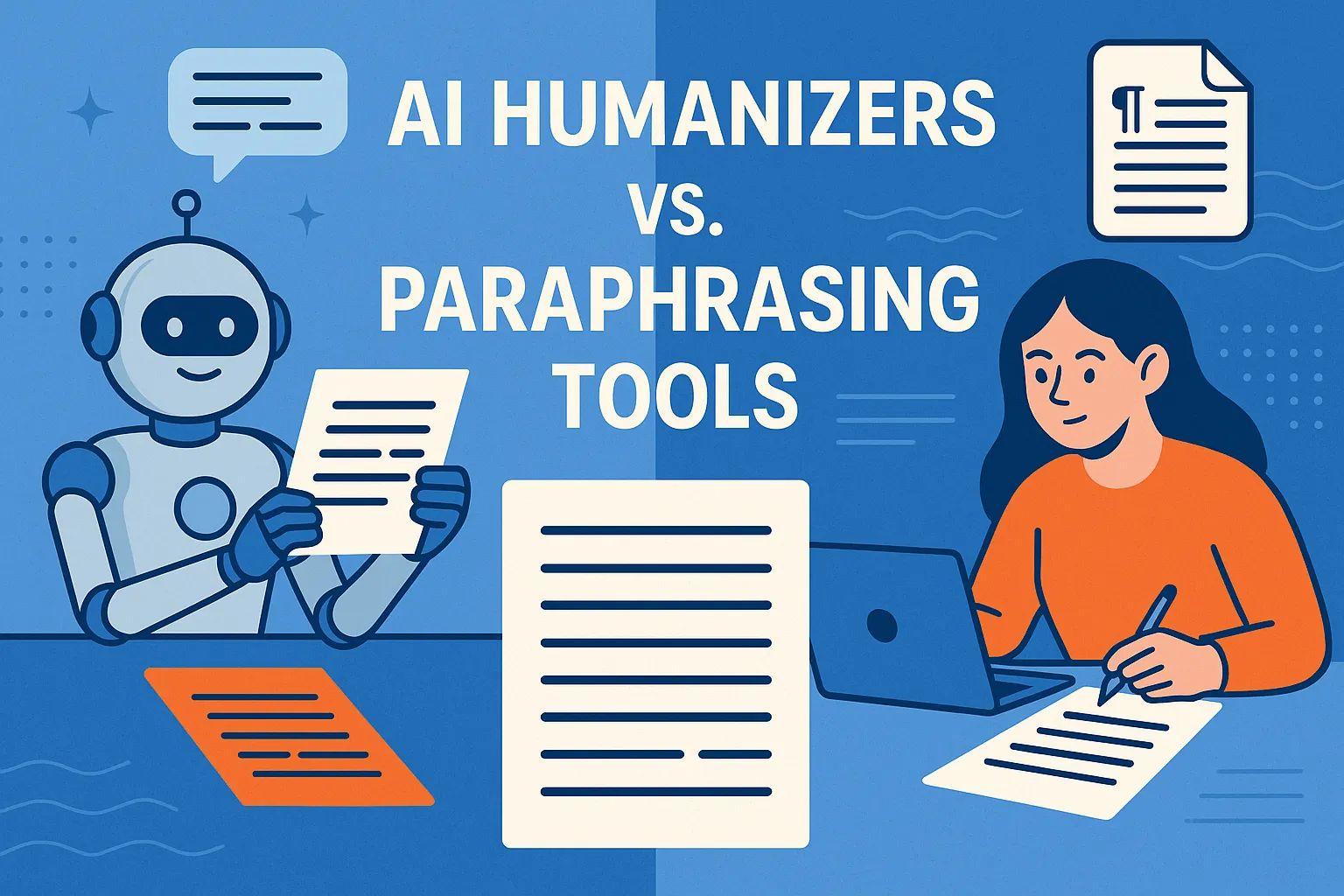AI Humanizers vs. Paraphrasing Tools: Key Differences
Compare AI humanizers and paraphrasing tools in 2025. Learn which tool rewrites AI content to sound human and which one improves clarity, grammar, and originality.

AI Humanizers vs. Paraphrasing Tools: Key Differences
AI humanization and paraphrasing are two essential techniques for transforming digital content. But what’s the difference? When should you use one over the other? Let’s break down how AI humanizers and paraphrasing tools work, where they excel, and how they affect writing quality, originality, and AI detection.
What Are AI Humanizers and Paraphrasing Tools?
AI Humanizers are built to make AI-generated content sound more human and natural. These tools adjust sentence structure, inject conversational tone, and reduce detectable AI markers. The goal is to help content bypass AI detectors like Turnitin AI or GPTZero. Tools like HumanizerPro specialize in this transformation, often used in marketing, SEO, and academic adaptation.
Paraphrasing Tools, on the other hand, focus on rewriting content to improve clarity, grammar, and structure. They use synonym databases and language models to simplify, reword, or restructure text without necessarily aiming to make it sound human. RewriterPro AI is a strong example that helps rewrite for fluency, correctness, and originality.
Comparison Table
| Feature | AI Humanizers | Paraphrasing Tools |
|---|---|---|
| Main Goal | Bypass AI Detection | Improve Grammar and Clarity |
| Writing Style | Natural, human-like | Structured, formal |
| Tone Control | High (conversational, casual, etc.) | Moderate to Low |
| Common Use Cases | Marketing, SEO, Academic Humanization | Academic, Research, Simplification |
| Detection Risk | Low | Moderate to High |
| Word Choice | Context-aware | Synonym-based |
| Best Tools | HumanizerPro, Undetectable AI | RewriterPro AI, QuillBot |
| Pricing | $12–$39/month | Often free or lower cost |
| Word Limits | 600–3,000 per input | Usually unlimited |
Real-World Examples
Example 1: Academic Rewrite
Before (AI-Generated Essay):
"The education system is a vital component in shaping future generations and providing them with the necessary tools to function effectively in society."
Paraphrased:
"Education plays a crucial role in equipping individuals with the skills needed to contribute meaningfully to society."
Humanized with HumanizerPro:
"Education isn't just about books—it helps people grow into confident, capable contributors to the world around them."
Example 2: Marketing Copy
Original GPT Output:
"This product offers comprehensive solutions to your daily needs."
Paraphrased:
"The product provides a range of features to meet everyday requirements."
Humanized:
"Tired of juggling your daily tasks? This tool has everything you need—simple, smart, and stress-free."
Example 3: Blog Writing
AI Text:
"AI models are being increasingly used in various domains for efficiency."
Paraphrased:
"AI is becoming more common across industries due to its efficiency."
Humanized:
"From marketing to healthcare, AI is everywhere—and it’s helping people get more done in less time."
Main Goals and Use Cases
AI Humanizers: Human-Like Text for Detection-Free Publishing
AI humanizers specialize in rewriting AI-generated content to make it sound like it was written by a real person. Tools like HumanizerPro use proprietary models that adjust syntax, word flow, and tone to mirror human style.
Use cases include:
- Bypassing AI detection tools like Originality AI
- Improving blog post relatability with informal, conversational tone
- Refining content for social media, ads, and storytelling
AI humanizers often add slight imperfections and colloquialisms to match human variability in writing, helping creators maintain authenticity.
Paraphrasing Tools: Polish, Precision, and Plagiarism Control
Paraphrasing tools are ideal for:
- Academic integrity (simplify citations or rewording properly)
- Technical documentation (rephrasing for clarity)
- Professional writing (like emails, reports, manuals)
They focus on formal correctness rather than bypassing detection, and are better for refining well-written drafts or simplifying complex input.
Core Technical Differences
| Method | AI Humanizers | Paraphrasing Tools |
|---|---|---|
| Word Selection | Context-based human phrasing | Synonyms from database |
| Sentence Flow | Variable and dynamic | Fixed and rule-based |
| Error Handling | Allows light imperfection for realism | Prioritizes flawless grammar |
| Tone Control | Flexible (casual, narrative, etc.) | Limited (formal or neutral) |
AI Detection and Humanization Accuracy
How Well Do They Bypass Detection?
- HumanizerPro: Achieves 90%+ human score in our best humanizer test
- RewriterPro AI: Rewrites clearly and accurately but achieves 85% or lower in humanization accuracy
- GPTZero vs Originality AI: GPTZero is generally more accurate, while Originality AI often produces false positives (flagging human-written content as AI-generated)
HumanizerPro consistently outperformed in generating undetectable text while maintaining natural style.
When to Use AI Humanizers vs Paraphrasing Tools
Choose an AI Humanizer if:
- You want to bypass AI detection (Turnitin, GPTZero, ZeroGPT)
- You're transforming ChatGPT content into human-like writing
- You’re publishing SEO blog posts, ad copy, or web content
Choose a Paraphrasing Tool if:
- You want to simplify language in an academic or formal context
- You’re reworking content for clarity, grammar, or structure
- You need to ensure originality without changing tone too much
Ethical Use and Transparency
Misusing these tools can lead to ethical issues, especially in education or professional environments. Here’s a reminder of how to use them responsibly:
AI Humanizer Do's:
- Disclose AI use when needed
- Use for tone and style enhancement, not to deceive
- Avoid using humanizers to bypass strict academic rules
Paraphrasing Tool Do's:
- Always cite original content
- Don’t paraphrase just to dodge plagiarism
- Maintain the original meaning and intent
Final Thoughts: Combine Them Smartly
Using both tools together can work wonders. Start with a paraphrasing tool to polish grammar and then run the text through an AI humanizer to improve tone and reduce AI detection risks.
If your goal is to make ChatGPT content sound human, tools like HumanizerPro are your best bet.
Related Reads:
- Best AI Humanizers (2025 Edition)
- What Is AI Humanization?
- AI Humanizers vs Detectors
- Undetectable AI Tools Reviewed
- Originality AI Review
Pro Tip: Want to humanize AI content for free? Try HumanizerPro’s demo to test it on your own writing or GPT-generated text.

Kamran Khan
Kamran Khan is the founder of AI Humanizer PRO and a leading voice in the ethical use of AI-generated content. With years of hands-on experience in AI, SEO, and digital publishing, he built HumanizerPro to help creators and professionals turn robotic AI text into clear, human-like writing that meets real-world standards.